Altera Cyclone II FPGA Starter User Manual
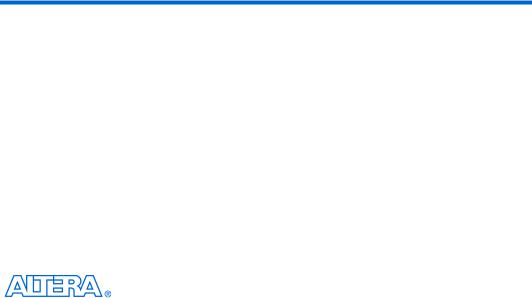
Cyclone II FPGA Starter Development Kit
User Guide
101 Innovation Drive |
|
|
San Jose, CA 95134 |
|
|
(408) 544-7000 |
Document Version |
1.0.0 |
http://www.altera.com |
Document Date |
October 2006 |
P25-36048-00

Copyright © 2006 Altera Corporation. All rights reserved. Altera, The Programmable Solutions Company, the stylized Altera logo, specific device designations, and all other words and logos that are identified as trademarks and/or service marks are, unless noted otherwise, the trademarks and service marks of Altera Corporation in the U.S. and other countries. All other product or service names are the property of their respective holders. Altera products are protected under numerous U.S. and foreign patents and pending applications, maskwork rights, and copyrights. Altera warrants performance of its semiconductor products to current specifications in accordance with Altera's standard warranty, but reserves the right to make changes to any products and services at any time without notice. Altera assumes no responsibility or liability arising out of the
application or use of any information, product, or service described herein except as expressly agreed to in writing by Altera Corporation. Altera customers are advised to obtain the latest version of device specifications before relying on any published information and before placing orders for products or services.
Printed on recycled paper |
UG-CDK01012-10 |
ii |
Altera Corporation |

Contents
|
|
.............................................................................About This User Guide |
v |
Chapter 1. Getting Started |
|
Introduction ............................................................................................................................................ |
1–1 |
Before You Begin ................................................................................................................................... |
1–1 |
Further Information .............................................................................................................................. |
1–2 |
Hardware Installation ........................................................................................................................... |
1–3 |
Software Installation ............................................................................................................................. |
1–3 |
Installing the Cyclone II FPGA Starter Development Kit CD-ROM ......................................... |
1–4 |
Installing the Quartus II Software .................................................................................................. |
1–5 |
Chapter 2. Development Board Setup |
|
Development Board Overview ............................................................................................................ |
2–1 |
Requirements ......................................................................................................................................... |
2–1 |
Powering Up the Development Board ............................................................................................... |
2–2 |
Confirming Board Operation ............................................................................................................... |
2–2 |
Chapter 3. Control Panel Setup |
|
Requirements ......................................................................................................................................... |
3–1 |
Hardware Setup ..................................................................................................................................... |
3–1 |
FPGA Configuration ............................................................................................................................. |
3–1 |
Control Panel Start ................................................................................................................................ |
3–2 |
Chapter 4. Using the Control Panel |
|
Control Panel Overview ....................................................................................................................... |
4–1 |
Controlling the 7-Segment Displays ................................................................................................... |
4–2 |
Lighting the LEDs .................................................................................................................................. |
4–3 |
PS/2 Keyboard ....................................................................................................................................... |
4–3 |
SDRAM/SRAM Controller and Programmer ................................................................................... |
4–4 |
Read/Write Data .............................................................................................................................. |
4–4 |
Sequential Write ............................................................................................................................... |
4–5 |
Sequential Read ................................................................................................................................ |
4–6 |
Flash Memory Programmer ................................................................................................................. |
4–6 |
Read/Write Data .............................................................................................................................. |
4–7 |
Sequential Write ............................................................................................................................... |
4–8 |
Sequential Read ................................................................................................................................ |
4–8 |
Configuring User Ports ......................................................................................................................... |
4–9 |
Flash Music Player ................................................................................................................................. |
4–9 |
VGA Display ........................................................................................................................................ |
4–11 |
Displaying the Default Image ....................................................................................................... |
4–11 |
Altera Corporation

Contents Cyclone II FPGA Starter Development Kit User Guide
Displaying Another Image from a Downloaded Bitmap File .................................................. |
4–12 |
Displaying Any Image Files ......................................................................................................... |
4–15 |
Chapter 5. Using the Development Board
Configuring the Cyclone II FPGA ....................................................................................................... |
5–1 |
JTAG Programming ......................................................................................................................... |
5–1 |
AS Programming .............................................................................................................................. |
5–1 |
Configuration Procedure ................................................................................................................. |
5–2 |
Configuring the FPGA in JTAG Mode ..................................................................................... |
5–2 |
Configuring the EPCS4 Device in AS Mode ........................................................................... |
5–3 |
Chapter 6. Advanced Examples
Factory Configuration ........................................................................................................................... |
6–1 |
File Locations .................................................................................................................................... |
6–1 |
Demonstration Setup ....................................................................................................................... |
6–1 |
Music Synthesizer Demonstration ...................................................................................................... |
6–2 |
File Locations .................................................................................................................................... |
6–4 |
Demonstration Setup ....................................................................................................................... |
6–4 |
SD Card Music Player ........................................................................................................................... |
6–5 |
File Locations .................................................................................................................................... |
6–6 |
Demonstration Setup ....................................................................................................................... |
6–6 |
iv |
Altera Corporation |
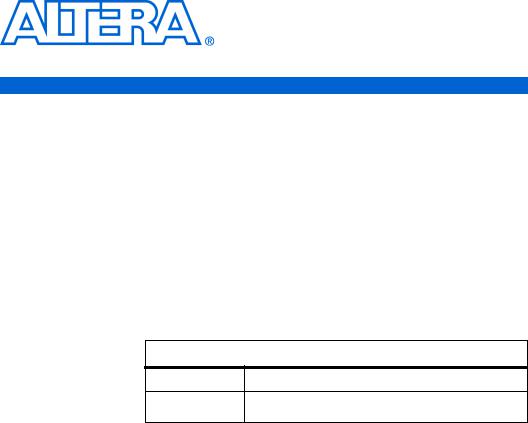
About This User Guide
This user guide describes how to start using the Altera® Cyclone® II FPGA Starter Development Kit, including unpacking the kit, installing required software, connecting the development board to a PC, and running sample software.
For a full description of the development board and its use, refer to the
Cyclone II FPGA Starter Development Kit Reference Manual.
fThe document revision history in Table 1–1 shows this document’s current version. To ensure that you have the most up-to-date information on this product, refer to the readme file on the provided CD_ROM for late-breaking information that is not available in this document.
Table 1–1. Document Revision History
Date |
Description |
October 2006 Initial publication of the Cyclone II FPGA Starter
Development Kit, version 1.0.0
How to Find Information
The following methods enable you to quickly find information in this Portable Document Format (PDF) type document:
■Search the contents by using the Adobe® Acrobat® or Reader® Edit/Find command or click on the binoculars/Search toolbar icon.
■The Bookmarks window serves as an additional table of contents. Click on a topic to jump to that section in the document.
■Thumbnail icons in the Pages window provide miniature previews of each page and provide a link to the pages.
■Within the text, hypertext links, highlighted in green, enable you to jump to related information.
How to Contact Altera
To get help regarding this product, use the following contact information:
■Altera Corporation 101 Innovation Drive
San Jose, California, 95134 USA www.altera.com
Altera Corporation |
v |
October 2006 |
|

Typographic Conventions Cyclone II FPGA Starter Development Kit User Guide
For the most up-to-date information about Altera products, go to the Altera world-wide web site at www.altera.com. For technical support on this product, go to www.altera.com/mysupport. For additional information about Altera products, consult the sources shown below.
Information Type |
USA & Canada |
All Other Locations |
|
|
|
Technical support |
www.altera.com/mysupport/ |
www.altera.com/mysupport/ |
|
|
|
|
(800) 800-EPLD (3753) |
+1 408-544-8767 |
|
(7:00 a.m. to 5:00 p.m. Pacific Time) |
7:00 a.m. to 5:00 p.m. (GMT -8:00) |
|
|
Pacific Time |
|
|
|
Product literature |
www.altera.com |
www.altera.com |
|
|
|
Altera literature services |
literature@altera.com |
literature@altera.com |
|
|
|
Non-technical customer |
(800) 767-3753 |
+ 1 408-544-7000 |
service |
|
7:00 a.m. to 5:00 p.m. (GMT -8:00) |
|
|
Pacific Time |
|
|
|
FTP site |
ftp.altera.com |
ftp.altera.com |
|
|
|
Typographic
Conventions
This document uses the typographic conventions shown below.
Visual Cue |
Meaning |
|
|
Bold Type with Initial |
Command names, dialog box titles, checkbox options, and dialog box options are |
Capital Letters |
shown in bold, initial capital letters. Example: Save As dialog box. |
|
|
bold type |
External timing parameters, directory names, project names, disk drive names, |
|
filenames, filename extensions, and software utility names are shown in bold |
|
type. Examples: fMAX, \qdesigns directory, d: drive, chiptrip.gdf file. |
Italic Type with Initial Capital |
Document titles are shown in italic type with initial capital letters. Example: AN |
Letters |
75: High-Speed Board Design. |
|
|
Italic type |
Internal timing parameters and variables are shown in italic type. |
|
Examples: tPIA, n + 1. |
|
Variable names are enclosed in angle brackets (< >) and shown in italic type. |
|
Example: <file name>, <project name>.pof file. |
|
|
Initial Capital Letters |
Keyboard keys and menu names are shown with initial capital letters. Examples: |
|
Delete key, the Options menu. |
|
|
“Subheading Title” |
References to sections within a document and titles of on-line help topics are |
|
shown in quotation marks. Example: “Typographic Conventions.” |
|
|
vi |
Altera Corporation |
|
October 2006 |

About This User Guide Typographic Conventions
Visual Cue |
Meaning |
|
|
Courier type |
Signal and port names are shown in lowercase Courier type. Examples: data1, |
|
tdi, input. Active-low signals are denoted by suffix n, e.g., resetn. |
|
Anything that must be typed exactly as it appears is shown in Courier type. For |
|
example: c:\qdesigns\tutorial\chiptrip.gdf. Also, sections of an |
|
actual file, such as a Report File, references to parts of files (e.g., the AHDL |
|
keyword SUBDESIGN), as well as logic function names (e.g., TRI) are shown in |
|
Courier. |
|
|
1., 2., 3., and |
Numbered steps are used in a list of items when the sequence of the items is |
a., b., c., etc. |
important, such as the steps listed in a procedure. |
|
|
■ ● • |
Bullets are used in a list of items when the sequence of the items is not important. |
|
|
v |
The checkmark indicates a procedure that consists of one step only. |
1 |
The hand points to information that requires special attention. |
c |
The caution indicates required information that needs special consideration and |
understanding and should be read prior to starting or continuing with the |
|
|
procedure or process. |
|
|
w |
The warning indicates information that should be read prior to starting or |
continuing the procedure or processes |
|
|
|
r |
The angled arrow indicates you should press the Enter key. |
f |
The feet direct you to more information on a particular topic. |
Altera Corporation |
vii |
October 2006 |
|
Typographic Conventions |
Cyclone II FPGA Starter Development Kit User Guide |
|
|
viii |
Altera Corporation |
|
October 2006 |

1. Getting Started
Introduction
f
Before You
Begin
Welcome to the Altera Cyclone II FPGA Starter Development Kit, which includes a full-featured field-programmable gate array (FPGA) development board, hardware and software development tools, documentation, and accessories needed to begin FPGA development.
The development board includes an Altera Cyclone II 2C20 FPGA and comes preconfigured with a hardware reference design stored in flash memory. Hardware designers can use the development board as a platform to prototype complex embedded systems.
The Development Kit provides the user with an integrated control environment that includes a software controller in C++, a USB command controller, a multi-port SRAM/SDRAM/flash memory controller, and demonstration circuitry specified in Verilog code. These features enable users to implement and test designs without the need to implement complex application programming interfaces (APIs), host control software, or SRAM/SDRAM/flash memory controllers.
This user guide addresses the following topics:
■How to set up, power up, and verify correct operation of the development board
■How to install the Altera Development Suite Tools and the Cyclone II FPGA Starter Development Kit CD-ROMs
■How to set up, and use the Control Panel, a graphical user interface (GUI), to manipulate components on the board, implement applications, and display images on a VGA monitor
■How to configure the Cyclone II FPGA
■How to set up and run application examples
For complete details on the development board, refer to the
Cyclone II FPGA Starter Development Kit Reference Manual.
Before proceeding, check the contents of the Development Kit:
■Cyclone II FPGA Starter Development board
Altera Corporation |
1–1 |
October 2006 |
|

Further Information
Further
Information
■Cyclone II FPGA Starter Development Kit CD-ROM containing the development board documentation and supporting materials, including the User Guide and Reference Manual, Control Panel utility, reference designs and demonstrations, device datasheets, tutorials, and a set of laboratory exercises
■The Altera Development Suite Tools CD-ROMs containing Altera Quartus® II 6.0 Web Edition design software and the Nios® II 6.0 embedded processor
■Bag of six rubber (silicon) covers for the development board stands and extender pins that facilitate easier probing of the board I/O expansion headers with testing equipment
■7.5 V DC wall-mount power supply
■Clear plastic cover for the board
Other items you will want to have available to work through this user guide are:
■VGA monitor
■Audio source such as a CD player or MP3 player
■Headphones
■PS/2 keyboard
For other related information, refer to the following websites:
■For additional daughter cards available for purchase:
http://www.altera.com/products/devkits/kitdaughter_boards.jsp
■For on-line demonstrations & training:
http://www.altera.com/education/demonstrations/demindex.html and https://mysupport.altera.com/etraining/
■For Cyclone II handbook: http://www.altera.com/literature/lit-cyc2.jsp
■For Cyclone II reference designs:
http://www.altera.com/end- markets/refdesigns/device/cyclone2/cyclone2-index.jsp
■For eStore if wish to purchase devices: http://www.altera.com/buy/devices/buy-devices.html
1–2 |
Altera Corporation |
Cyclone II FPGA Starter Development Kit User Guide |
October 2006 |
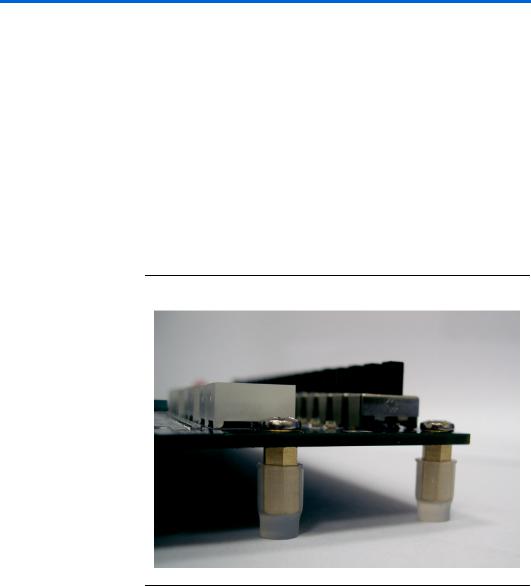
Getting Started
Hardware
Installation
Software
Installation
Altera Corporation
October 2006
■For Cyclone II Orcad symbols:
http://www.altera.com/support/software/download/pcb/pcbpcb_index.html
■For Nios II 32-bit embedded processor solutions: http://www.altera.com/technology/embedded/emb-index.html
w Before beginning any work, prepare the board as follows:
■Assemble a rubber (silicon) cover (Figure 1–1) for each of the six copper stands on the board
■Mount the clear plastic cover over the top of the board for extra protection by using additional stands and screws
Figure 1–1. Board Stand Covers
The instructions in this section describe how to install the following:
■Cyclone II FPGA Starter Development CD-ROM
■The Quartus II Software, Development Kit Edition
1–3 Cyclone II FPGA Starter Development Kit User Guide

Software Installation
Installing the Cyclone II FPGA Starter Development Kit CD-ROM
The Cyclone II FPGA Starter Development Kit CD-ROM contains the following items:
■Sample design files and board design files for the kit
■Cyclone II FPGA Starter Development Kit User Guide (this document)
■Cyclone II FPGA Starter Development Board Reference Manual
To install the Cyclone II FPGA Starter Development Kit CD-ROM, perform the following steps:
1.Insert the Cyclone II FPGA Starter Development Kit CD-ROM into the CD-ROM drive.
1The CD-ROM should start an auto-install process. If it does not, browse to the CD-ROM drive and double-click on the setup.exe file.
2.Follow the online instructions to complete the installation process. The installation program copies the Cyclone II FPGA Starter Development Kit files to the hard-disk and creates a
Programs > Altera > Cyclone II FPGA Starter Development Kit v1.0.0
icon, accessible from the Windows Start menu. Use this icon to launch the Windows-style development kit GUI.
The Cyclone II FPGA Starter Development Kit installation program creates a directory structure for the installed files (Figure 1–2), where <path> is the selected Cyclone II Starter Development Kit installation directory.
Figure 1–2. Cyclone II Starter Kit Installed Directory Structure
CII_Starter_Kit-v1.0.0
1–4 |
Altera Corporation |
Cyclone II FPGA Starter Development Kit User Guide |
October 2006 |
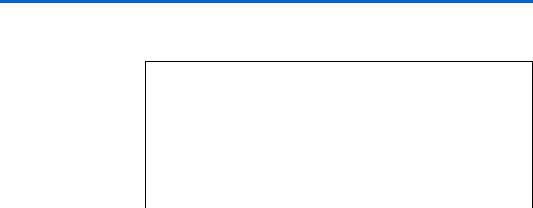
Getting Started
Table 1–1 lists the file directory names and a description of their contents.
Table 1–1. Installed Directory Contents
Directory Name |
Description of Contents |
|
|
BoardDesignFiles |
Contains the board design files. Use these files |
|
as a starting point for a new prototype board |
|
design. |
|
|
Docs |
Contains the development kit documentation |
|
|
Examples |
Contains the sample design files for the Cyclone |
|
II FPGA Starter Development Kit |
|
|
Installing the Quartus II Software
Install the Quartus II Web Edition Software Suite found in the Altera Design
Software Suite by performing the following steps:
1.Insert the Quartus II Web Edition Software Suite CD-ROM into the CD-ROM drive.
1The CD-ROM should start an auto-install process. If it does not, browse to the CD-ROM drive and double-click on the setup.exe file.
2.Follow the online instructions to complete the installation process.
1If you have difficulty installing the Quartus II software, refer to
Installing the Quartus II Software in the Quartus II Installation & Licensing Manual for PCs found at www.altera.com.
The Quartus II software is the primary FPGA development tool used to create the reference designs used in this development kit.
Additionally, you may want to install the Nios II Embedded Design Suite package also found in the Altera Design Software Suite. The Nios II soft-core embedded processor runs on Altera FPGAs. Many of the reference designs included in this development kit use the Nios processor.
Altera Corporation |
1–5 |
October 2006 |
Cyclone II FPGA Starter Development Kit User Guide |

Software Installation
1–6 |
Altera Corporation |
Cyclone II FPGA Starter Development Kit User Guide |
October 2006 |
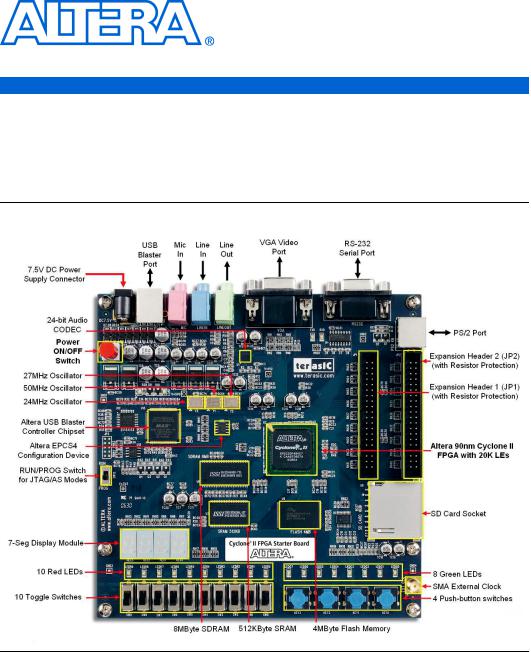
2. Development Board Setup
Development
Board Overview
Altera delivers the development board (Figure 2–1) with a preloaded configuration to demonstrate features of the board. At power up, the preloaded configuration also enables users to confirm quickly that the board is operating correctly.
Figure 2–1. Cyclone II Development Board Layout and Components
Requirements |
Preparation for using the development board requires the following |
|
prerequisite actions: |
Altera Corporation |
2–1 |
October 2006 |
|
